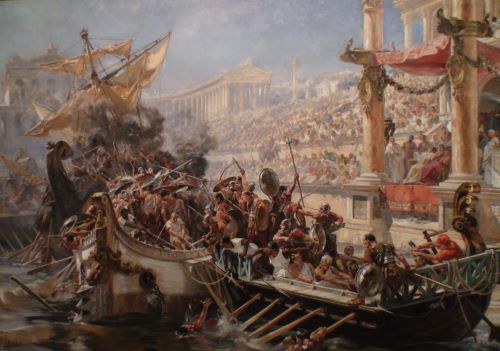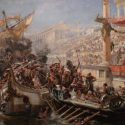Naval battles in the Colosseum – the “Naumachiae”
The naval battles in the Colosseum, the famous “naumachiae”, are one of the many wonders of ancient roman times. So what where the naumachiae exactly? How could they represent naval battles in the Colosseum? Read more and come and visit the Colosseum with one of our special guided TOURS, we’ll be glad to tell you more about the naval battles in the Colosseum, the “naumachiae”.
The Naumachiae – What are they?
Naumachiae were simulations of naval battles held in natural or artificial basins. These were flooded for the occasion. The naumacharii, i.e. the combatants, were enemy fallen slaves, or people hired on the spot. They could also be paid sailors or criminals sentenced to death.
The Greek word “naumachia” indicates both a spectacle representing a naval battle and the basin in which these were held.
These spectacles, devised and performed in Rome (and some in the Colosseum), were rarely performed elsewhere. They were very expensive, as the ships were authentic, and manoeuvred like real ships in battle, crashing into each other or even sinking.
Caesar’s First Naumachiae
The first naumachia was held in Rome in a temporary basin excavated in the Campus Martius, in the Trastevere area. In 46 BC Caesar financed one for his triumphs. Caesar’s naumachia was, therefore, arranged in a large basin near the Tiber. Its depth was 11 or 12 m, so that water could seep out of the ground and ships could keep afloat. This temporary basin received water from a channel of the Tiber and returned to the Tiber.
Caesar had hired some 6,000 people (2,000 fighters and 4,000 oarsmen). A huge crowd from the nearby colonies had camped in the streets and squares so as not to miss the spectacle. The crowd was so large that, as Suetonius narrates, several people died in the crowd.

Naumachiae at the Colosseum
Naumachiae at the Colosseum
The Colosseum could become a naumachia when the scene was flooded by an ingenious irrigation system. It seems, however, that it was used for this purpose only at its inauguration, or at any rate only a few times.
Martial narrates that naumachiae were held at the Colosseum in the first years after its inauguration. Modern archaeologists claim that they were abandoned because “many preparations were needed to make the arena watertight and fill it to a sufficient height to be able to float ships in it”.
Some scholars think that the underground passages of the Colosseum were excavated only a few years after the inauguration, otherwise its flooding would not have been impossible.
The numbers of the naval battles in the Colosseum
The basin had to have a depth of about 1.5 m, the minimum depth to allow ships to float. It had a capacity of about 200,000 m3. The aqueduct specially built for its supply, could fill it in 15 days. A navigable canal allowed access to ships coming from the Tiber, crossing by a movable bridge.
Considering the size of the basin and that usually more that 30 boats were employed in these battles, a quick calculation allows us to conclude there were a minimum of 4000/6000 men involved.
Read more and come and visit the Colosseum with one of our special guided TOURS, we’ll be glad to tell you more about the naval battles in the Colosseum, the “naumachiae”.

